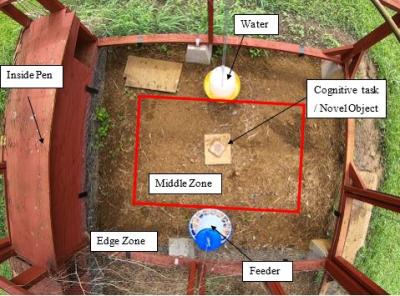Methods

In total, 42 feral chickens were collected across Kauai island in August 2019 and brought to CTAHR (College of Tropical Agriculture and Human Resources) where they were kept in an experimental pen for 1.5 days for behavioural testing. In October 2019, the same tests were performed on 10 domestic White Leghorn chickens at Vreta, Linköping.
Fear-related tests
Five standardized and commonly used fear-related tests that have some genetic influence and differ between domesticated and wild animals were used to measure fear. See below for a brief description on each and how it relates to fearfulness and anxiety.
1) Emergence: the latency of which an individual emerges from an inside pen within the enclosure. A more anxious animal is thought to have a longer latency of emergence.
2) Open Field: the proportion of time an animal spends in a middle zone of the pen versus the edge zones. Thigmotaxis, the tendency to stay close to walls in the edges of the pen, is a sign of anxiety.
3) Novel Object: the interest in a novel object was measured, as increased exploration behaviour is negatively associated with fear and anxiety. The novel object consisted of a piece of wood with a well that was baited with food, covered with a plexiglass lid that had to be moved to either side to access the food.

4) Predator test: a plastic model of a bird of prey was pulled along the front side oft he pen. An appropriate response to a potential predator would be to increase vigilance, move to the edge areas of the pen or seek shelter inside, alarm call and/or decrease movement. These behaviours were measured during the 5 minutes before and 5 minutes after the model was shown.
5) Tonic immobility: this state is thought to be an antipredator response and induced by a short period of light pressure on the chest of the chicken, while put on its back. Red Junglefowl generally show a higher duration of tonic immobility compared to domestic breeds, but it is more difficult to induce.
Behavioural measures
Additionally, behaviour was observed for 120 minutes across two days. Video recordings allowed continuous focal sampling for each individual. Behavioural budgets were created for the following behavioural categories: comfort behaviours, consuming, locomoting, pacing, standing, being vigilant, spending time in the inside pen and out of sight.
Furthermore, the frequency of the following behaviours was recorded: dominant interactions, subordinate interactions, interaction with the novel object, alarm calls, and crows.
Across the same timespan, general movement was recorded each second, measuring the distance moved and at what speed.
Brain composition
Lastly, the chickens were culled and four-piece brain dissections were conducted. The sections were divided in: the cerebellum, cerebral hemispheres, optic tecum and midbrain/brainstem. Each section was weighed to the nearest 0.001 gram.
Analyses
Data were analysed in R and the main objectives of performed statistical tests were to:
- investigate the repeatability of all behavioural measures
- compare feral and domesticated populations in all parameters
- correlate behavioural measures to investigate behavioural patterns
- correlate behavioural measures with brain composition to investigate general relationships between them
Responsible for this page:
Director of undergraduate studies Biology
Last updated:
05/25/20
